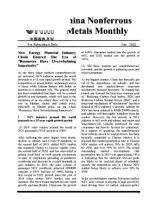Sodium-ion Battery Enjoys Huge Potentials in Full Commercialization
Recently, in the reply letter from MIIT to No.4815 Proposal put forth in the 4th Session of 13th National Committee of CPPCC (industrial transportation, post and telecommunications No.523), MIIT announces that relevant government departments will accelerate the application of innovation achievements in sodium-ion battery and support the construction of batch production capacity of advanced products.In the meantime,relevant government departments will improve related catalog in time based on industrial development process, facilitate the application of eligible sodium-ion batteries with excellent capability in new energy power station,transportation tools and communication base station.Relevant government departments aim to boost full commercialization of sodium-ion battery through collaborative innovation by bringing together enterprises, academia, and research institutes.
Recently, in the reply letter from MIIT to No.4815 Proposal put forth in the 4th Session of 13th National Committee of CPPCC (industrial transportation, post and telecommunications No.523), MIIT announces that relevant government departments will accelerate the application of innovation achievements in sodium-ion battery and support the construction of batch production capacity of advanced products.In the meantime,relevant government departments will improve related catalog in time based on industrial development process, facilitate the application of eligible sodium-ion batteries with excellent capability in new energy power station,transportation tools and communication base station.Relevant government departments aim to boost full commercialization of sodium-ion battery through collaborative innovation by bringing together enterprises, academia, and research institutes.
Relevant government departments are making efforts in accelerating application and industrial development of new energy technologies,during which new power batteries are the most important part.Lithium-ion battery technologies are the most developed among all battery technologies including hydrogen vehicle, fuel cell and lithium-ion battery.However, the industry relies too much on rare metal minerals like lithium, cobalt and nickel to develop lithium-ion battery.Although China is abundant in lithium battery, our self-owned lithium, cobalt and nickel are not able to meet huge consumption demands.We need to greatly import from other countries, so there are still big risks of “cutthroat” in upstream resources.In addition, global reserves for lithium, cobalt and nickel resources are limited, making it hard for lithium battery industry to march towards TWh era.In comparison, sodium-ion batteries boast significant advantages:
Firstly, advantage in resources.Sodium is rich in reserves and is widely spread.Above all,sodium is the 6th most abundant element in the Earth's crust, with the abundance of 2.74%,400 times the amount of lithium.Besides,sodium is evenly distributed geographically and is at a low cost because where there is sea water, there is sodium chloride.Second of all, sodium-ion batteries do not require rare precious metals like cobalt and nickel for positive electrodes, which helps to get rid of dependence on rare resources.
Secondly, advantage in cost.Material cost takes up a big proportion in battery cost.Sodium salt, a primary material in sodium-ion batteries, has a much lower price than lithium salt.With a relatively stable price, the risks of price fluctuations caused by shortage of lithium supply can be avoided.Sodium-ion batteries do not require rare precious metals like cobalt and nickel for positive electrodes, which helps to reduce the cost.Additionally, aluminum foil,whose price is lower, can be used as negative current collector in the place of copper foil.To sum up, it is estimated that material cost can be reduced by 30-40% comparing sodium-ion batteries to lithium-ion batteries.
Thirdly, advantage in production line.Sodiumion batteries and lithium-ion batteries are rather similar in working principles and battery structure.With just a few adjustments to current production line for lithium-ion batteries, the updated production line can be utilized to produce sodium-ion batteries.
Fourthly, advantage in safety.Sodium-ion batteries are very safe because they do not catch fire or explode in safety tests including stabbing, extruding, overcharging and over discharging.0V transportation can be realized in transportation process, which lowers the risks in battery transportation.Comparatively,lithium-ion batteries use copper foil as negative current collector.When at low voltage, copper foil easily gets oxidized, which will lead to performance degradation and battery failure.In order to solve this problem,before transportation, lithium-ion batteries need to be charged to over 80%, which creates higher risks for transportation compared to low-battery transportation.In contrast, sodiumion batteries have the stable aluminum foil replace copper foil, which help to get rid of the problems of performance degradation or battery failure due to low voltage.Batteries can be totally discharged before transportation,which ensures transportation safety and does not affect battery performance in the long run.
To sum up, under dual impetus of “policy+ market”, all parts of industrial chains in China’s NEV market are developing fast and extensively, leading to all kinds of technologies emerging.But in the end, the market is the decision maker for the technical directions in which we are heading.Sodium-ion battery is still in its initial stage for industrialization,with unimproved industry chain and unfinished scale effect, but there is great potential in development.Once sodium-ion battery enters mass production phase with technologies getting all developed, it will create huge impact to lithium iron phosphate market.The market is fully paying attention to its technical trend and market trend.

